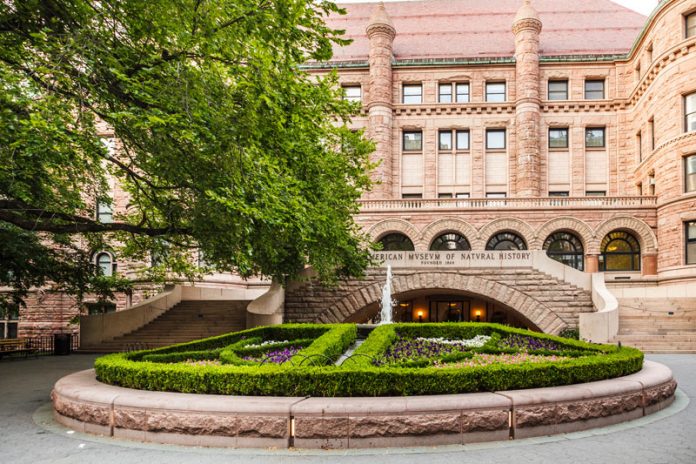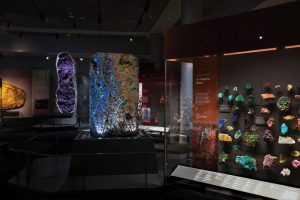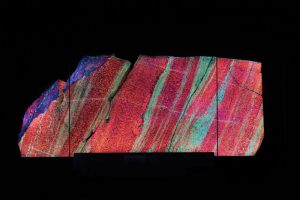
The American Museum of Natural History is one of the scientific treasures of our country. Countless millions have visited its halls and marveled at the history of the natural world so well displayed in the vast halls of this centrally located museum. The main museum is just a stone’s throw from Central Park in the heart of the city and is often referred to as the New York Museum. As it developed, it was supported by some of the wealthiest people like J.P. Morgan, Washington Roebling and many important families and foundations.
Now, thanks to many more benefactors, the Allison and Roberto Mignone Hall of Gems and Minerals, has an amazing 11,000 square feet of displays. Using minerals and gems, the hall tells the story of the evolution of the earth from its birth in space billions of years ago to today.
How it Began

FININ, AMERICAN MUSEUM OF NATURAL HISTORY
The American Museum of Natural History had its beginnings when the state of New York, in 1859, passed a bill for the establishment of a museum. Five years later, construction started, and in 1873 the Museum officially opened on Central Park West. From that simple beginning, the American Museum complex has grown to encompass 10 buildings housing major collections of every facet of earth, nature, and science.
The gem and mineral collection on display in previous years was typical of mineral displays with labeled mineral specimens displayed in rows.
Dr. Fred Pough
Museum curator, Dr. Fred Pough was known to collectors through his superb mineral collector’s text, “Field Guide to Rocks and Minerals.” As the hobby grew after World War II, Pough saw the need for a mineralogy book designed for the amateur collector. In 1953, his field guide was published and is now in its fifth edition. Through his writings and his work at this museum, Fred undoubtedly impacted the hobby more than anyone else. He became so well known as a gem expert in New York that he was featured in a comic book about gems and the museum.
Ironically, in 1964 there actually was a gem theft at the American Museum featuring a character named “Murph the Surf.” He, along with others, climbed through a bathroom window and stole a couple of dozen loose diamonds, including the 16.24-carat Eagle diamond, the 100-carat Delong Star Ruby and the Star of India sapphire, 573 carats. The gems were eventually recovered, and this last beauty, the Star of India, is back on display in the new hall. However, the Eagle diamond was never recovered and was probably split up. Murph and his ilk ended up in jail.
The New Hall of Gems & Minerals

The new hall, curated by George Harlow, is a complete shift to a modern, scientific approach of exhibiting minerals with an overall educational theme based on mineral evolution. Harlow has done a masterful job of managing the collection that has grown under his tenure to some new 5,500 specimens.
Themed Exhibits
The American Museum has joined a movement among public museums to use the evolution of a few dozen known early mineral species, considered the building blocks of today’s universe and planetary system to the complex earth mineralogy of today of some 5,000 species with more still being discovered. We now know the earth and the universe around it is an ever-evolving story of the known 92 natural elements that make up every type of rock group; igneous, metamorphic and sedimentary, which make up of the earth’s minerals.
The new exhibits demonstrate how the earth eventually formed as meteors and comets drew together, forming our planet. Once formed, the forces of gravity, weathering and all the other forces brought about those three major rock types, each with its own complex suite of minerals. Today we use the minerals in industry, jewelry, and the growth of today’s modern age.
From Ordinary to Extraordinary
All this is displayed in the redesigned Allison and Roberto Mignone Gem and Mineral Hall, culminating with wonderful mineral exhibits that range from quite ordinary but beautifully crystallized species, many of them recently obtained, to classic examples of species of historically important minerals. What could be older and more appropriate than a nine-pound almandine garnet recovered during the building of a subway tunnel in the ancient metamorphic rock upon which Manhattan is built? Benefactor Allison Mignone describes walking into the new gem and mineral hall as being like “walking into a jewel box.” Several large examples of minerals add to the overall stunning visual impact upon entering the new hall.
One such pair of large specimens is an Uruguay amethyst geode that has been cut in half to expose the lustrous violet amethyst quartz crystals lining the interior walls of the geode. This huge amethyst geode is an astonishing 12,000 pounds, among the largest in the world, and was recovered from the Molsa mine in Uruguay.
Copper Ore
Of all the large specimens on exhibit, a favorite is an old-timer that dates back to the 1880s from Arizona, a four-and-a-half-ton solid block of copper ore. This block of sulfide and secondary copper minerals had been mined in the Copper Queen mine in the 1980s, during the heyday of this famous copper mine. The mine owners had been invited to exhibit minerals from Bisbee at the 1893 Chicago Exposition.
The exhibit included fine specimens and the huge ore block. This block was shown purposely to attract investors to buy stock in the young mining company. Once the Exposition ended, the Bisbee minerals were sold off and the massive block of ore was shipped to the American Museum for display. Upon arrival, the museum folks realized there was a problem. At four and a half tons, the floor could not hold the copper beauty. The floor had to be reinforced before it could be put on display.
Copperman Mummy
Another interesting exhibit is Copperman, the mummified remains of an ancient Chilean native copper miner unearthed during copper mining in Chile in the 1920s. With his leather bag and stone hammer, he had been tunneling in a zone of copper when the tunnel collapsed on him. When found, he was named Copperman and shipped to the American Museum, where he was displayed with much fanfare. The problem is folks expected to see a mummy replaced by native copper and what they saw were the dull grayish dried-out remains of a human. Copperman had to be removed from the exhibit but has since returned for viewing.
Fluorescent Minerals

FININ, AMERICAN MUSEUM OF NATURAL HISTORY
The obvious trend in redesigned museums is to feature large specimens along with a variety of eye-catching minerals, historically important species, and at some point, precious gems and jewelry. American Museum follows this pattern. The Mineral Hall is coupled with precious gem exhibits.
Of the large specimen exhibits, the one that will catch every child’s eye is the huge wall-like display of bright green and red fluorescent minerals from Sterling Hill, New Jersey, measuring 16 feet by seven feet and 10 inches high. The wall weighs nearly a ton and looks like an ordinary rock, but under various forms of ultraviolet light excitation, the wall glows bright red and green. This display explains what makes minerals fluorescent and is made of calcite and willemite from the New Jersey deposits, which are world-famous for the variety of fluorescent minerals found there.
Gem Exhibits
The gems are, of course, the big draw of the general public. The Star of India, with its exciting history and rarity, will always be popular. After all, it is the largest gem blue sapphire in the world, which was formed in rocks two billion years old. The Delong Ruby adds its lore to the exhibits. These beauties, along with many others, give visitors a lot to absorb.

FININ, AMERICAN MUSEUM OF NATURAL HISTORY
Along with the gems is one necklace that deserves mention. Many consider crocodiles among the ugliest animals on earth. Who can love one of these big ugly beasts? Well, actress María Félix could. She thought crocodiles were just fine and worthy of being replicated for jewelry. She actually took a live small crocodile to Cartier’s in Paris and they created a gold version, replicating the scales for a more realistic effect and made a necklace pendant jewel of gold embedded with over 60 carats of yellow diamonds and nearly 67 carats of emeralds. This stunning beauty is displayed with other gems in the Keith Meister Gallery of Gems as part of the Nils Hermann, Cartier collection.
Make Time to Visit
As is the case with other gem and mineral halls recently updated, a visitor should plan for lengthy and multiple visits to the American Museum to fully enjoy and study the presentations and exhibits. Each new hall represents an opportunity to learn about our earth’s minerals that are so critical to its development and so necessary in our lives today.
This story about the American Museum of Natural History appeared in Rock & Gem magazine. Click here to subscribe. Story by Bob Jones.












